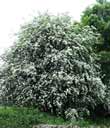
Wildlife gardening
Trees, hedges, shrubs and flowers
to attract wildlife to your garden
Planting flowers, trees and shrubs in your garden helps to redress the balance caused by disappearing woods, hedgerows and farmland. As these disappear, British animals also disappear because their natural food and habitat is destroyed. Even if your garden is small or in a city it can prove a haven and lifeline for wildlife. Allowing certain species of native wild flowers a place in your garden can be beneficial to wildlife and beautiful to behold.
Trees |
|
| Native British trees including hawthorn and oak are valuable to insects, birds and other animals as they provide shelter and food. Introduced species offer far less to our native creatures. Oak trees support the most insects, but are too large for most gardens. Willow, birch or hawthorn are good alternatives. Trees such as beech, ash and hazel also produce seeds or fruit. The fruit of apple trees is a valuable source of food for many birds in autumn or winter. |
|
Hedges |
| Dense hedges give birds protection from predators and provide windbreaks. Dense undergrowth encourages small birds such as wrens and dunnocks. Hawthorn is the best hedge, followed by holly, yew and wild privet. Holly berries are borne on the female holly plant, provided there is male bush nearby. Unclipped hedges of all types have more chance of bearing flowers and fruit. |
Shrubs |
||
 |
 |
Shrubs provide shelter for birds enabling them to nest safely. Some, such as cotoneaster and pyracantha provide berries. Climbers such as honeysuckle and ivy are attractive to birds. Ivy is late flowering and bears fruit and flowers for winter food. Heather and lavender seeds are eaten by finches. |
Flowers |
||
|
|
 |
Insects are needed by young birds, so try to avoid using pesticides. Aphids are attracted to early flowering plants such as aubretia, and provide a valuable source of food. If you can, leave seed heads of forget me nots and pansies for the birds to enjoy. Similarly if you leave your perennial flower stems in the autumn, birds will be attracted to them, searching for seeds and hiding insects. Cornflowers have edible autumn seeds and sedums are autumn flowering plants that attract insects and butterflies. |
It is relatively easy to cater for birds, butterflies and other creatures by growing plants specifically to encourage them to your garden. Less 'manicured' gardens probably attract more wildlife. For example, small tortoiseshell butterflies lay their eggs on stinging nettles, finches eat thistle seeds and hedgehogs hibernate under piles of leaves and twigs. You may be able to attract goldfinch by growing teasel specifically for them. The thought of growing stinging nettles and thistles may horrify many gardeners, but if you can devote a spare, unused corner to them, (or grow them in a large container to restrict their spread) they can attract additional wildlife to your garden.
Click on each of the images below for a larger view
The image at the top right is a peacock butterfly, lower right is a red admiral. Both are feeding on a buddleia shrub, a magnet to butterflies and many flying insects. Stinging nettles are allowed to grow unhindered by the side of the garden shed. Something has certainly made a meal of them! Goldfinches are attracted to the thistle heads - lower left. This year I am growing teasles, which are also particularly favoured by gold finches. |
||
Many people would be happy with a balance between tidy and overgrown. I also have many wild flowers in my garden which I value as attractive plants and worthy of a place there.
| Attract wildlife by building
a pond or a bird
nest box or grow wild flowers
|
| Spring wild flowers in deciduous woodland |





